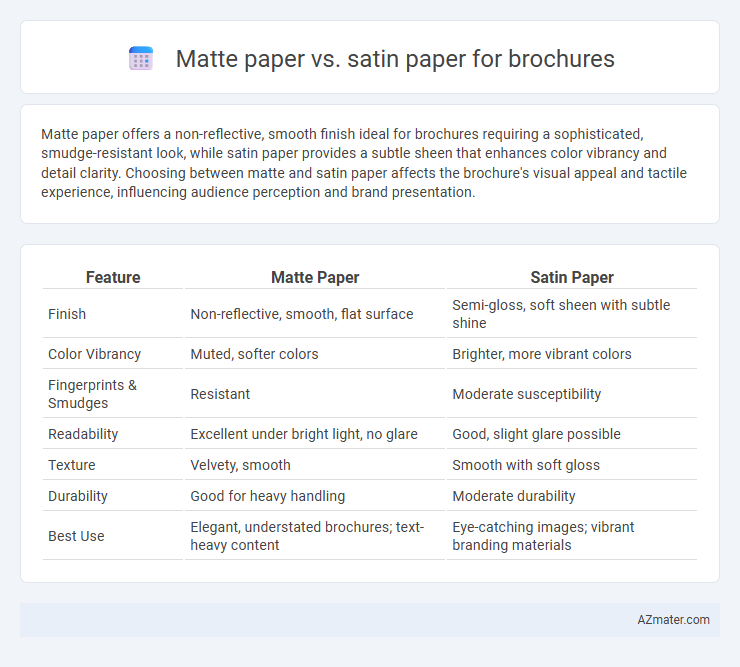Matte paper offers a non-reflective, smooth finish ideal for brochures requiring a sophisticated, smudge-resistant look, while satin paper provides a subtle sheen that enhances color vibrancy and detail clarity. Choosing between matte and satin paper affects the brochure's visual appeal and tactile experience, influencing audience perception and brand presentation.
Table of Comparison
| Feature | Matte Paper | Satin Paper |
|---|---|---|
| Finish | Non-reflective, smooth, flat surface | Semi-gloss, soft sheen with subtle shine |
| Color Vibrancy | Muted, softer colors | Brighter, more vibrant colors |
| Fingerprints & Smudges | Resistant | Moderate susceptibility |
| Readability | Excellent under bright light, no glare | Good, slight glare possible |
| Texture | Velvety, smooth | Smooth with soft gloss |
| Durability | Good for heavy handling | Moderate durability |
| Best Use | Elegant, understated brochures; text-heavy content | Eye-catching images; vibrant branding materials |
Introduction to Brochure Paper Types
Matte paper offers a non-reflective surface that enhances readability and provides a smooth, elegant finish, ideal for brochures with detailed text and subtle designs. Satin paper combines a soft gloss with a smooth texture, delivering vibrant colors and sharp images while reducing glare, making it perfect for visually rich brochure layouts. Choosing between matte and satin paper depends on the brochure's purpose, desired aesthetic, and printing requirements to achieve optimal presentation and durability.
What Is Matte Paper?
Matte paper is a non-glossy, smooth-textured surface that reduces glare and offers excellent readability for brochures, making it ideal for dense text and professional presentations. Its fingerprint-resistant finish ensures brochures maintain a clean, elegant appearance even after handling. Matte paper enhances color accuracy with a muted look that prevents colors from appearing overly vibrant or reflective, providing a sophisticated visual appeal for marketing materials.
What Is Satin Paper?
Satin paper features a smooth, semi-gloss finish that enhances color vibrancy and provides a subtle sheen, making it ideal for brochures requiring a polished yet understated look. It balances the muted texture of matte paper with improved durability and resistance to fingerprints, offering a professional presentation without the glare of high gloss. Satin paper is favored in marketing materials where image clarity and tactile quality are essential for engaging potential customers.
Visual Appeal: Matte vs Satin
Matte paper offers a non-reflective, smooth finish that enhances readability and gives brochures a sophisticated, understated elegance. Satin paper provides a subtle sheen that balances vibrancy and softness, making colors appear more vivid without glare. Choosing between matte and satin depends on whether you want a refined, muted look or a brighter, eye-catching presentation for your brochure.
Print Quality Comparison
Matte paper offers a non-reflective, smooth finish that enhances readability and minimizes glare, making it ideal for brochures with detailed text and subtle color tones. Satin paper provides a slight sheen that intensifies color vibrancy and sharpness, resulting in visually striking images and a more polished look. Both paper types support high-resolution print quality, but satin excels in showcasing vivid graphics while matte ensures a more elegant, muted presentation.
Touch and Feel: Texture Differences
Matte paper offers a smooth, non-reflective finish that provides a soft and elegant touch, ideal for brochures requiring a subtle, sophisticated feel. Satin paper combines a slight sheen with a smooth texture, delivering a silky touch that enhances color vibrancy while maintaining a professional look. The tactile difference lies in matte's muted softness versus satin's gentle gloss, influencing the brochure's overall sensory impact.
Durability and Longevity
Matte paper offers excellent durability with a non-glossy finish that resists fingerprints and scratches, making it ideal for brochures intended for frequent handling. Satin paper combines a smooth texture with a subtle sheen, providing moderate durability while enhancing color vibrancy and resisting minor wear. Both options feature strong longevity, but matte paper generally outperforms satin in maintaining appearance over extended use.
Cost Considerations
Matte paper for brochures generally costs less than satin paper due to its simpler coating and manufacturing process, making it a budget-friendly option for large print runs. Satin paper, with its slight sheen and smoother finish, typically incurs higher expenses related to production and quality control. Choosing matte paper can reduce overall brochure printing costs, while satin paper may justify its price through enhanced visual appeal and durability.
Best Applications for Matte and Satin Brochures
Matte paper excels in creating brochures that emphasize readability and a professional, elegant appearance without glare, making it ideal for text-heavy materials, business presentations, and luxury brands. Satin paper offers a subtle sheen that enhances color vibrancy and image sharpness, perfect for brochures showcasing vibrant photography, retail promotions, or artistic designs where visual impact is crucial. Choosing matte paper suits formal, understated marketing, while satin paper elevates brochures needing a balance of gloss and sophistication for eye-catching appeal.
Choosing the Right Paper for Your Brochure
Matte paper offers a non-reflective finish that enhances readability and is ideal for brochures with text-heavy content, providing a smooth, elegant feel that reduces glare. Satin paper balances the best of matte and glossy finishes, delivering vibrant color reproduction and a subtle sheen that appeals to visually rich brochures. Choosing the right paper depends on your brochure's purpose, desired aesthetic, and the importance of color vibrancy versus readability and texture.

Infographic: Matte paper vs Satin paper for Brochure
 azmater.com
azmater.com